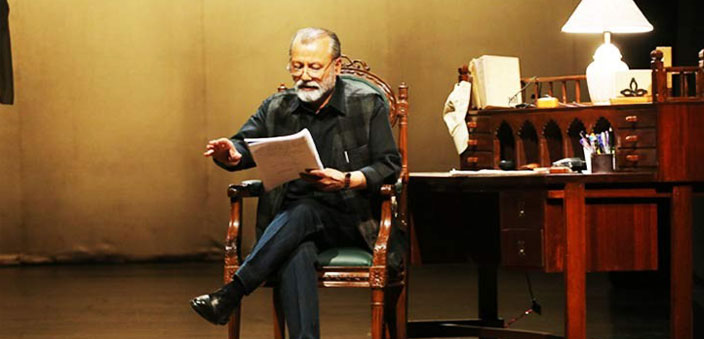Pankaj Kapur (born 1954), is a well-known face in the world of cinema and some acclaimed TV serials like Neem ka Ped, Karamachand and Office Office. But his first love is theatre. He became a student of NSD (National School of Drama) when he was only 19.
He has now returned to the stage with his one-act play in Hindustani Dopehri, based on his own novella written some 20 years ago. The show lasts for about 90 minutes but audiences do not leave the theatre even for a nano second while Pankaj Kapur narrates the story of Amma Bi.
Pankaj Kapur and his wife Supriya Pathak, both are alumni of NSD. Their love for theatre is well-known. To return to this love, they recently started a drama group ‘Theatron’ under which Dopehri is produced, their first production. What is Dopehri? It is an afternoon time. Pankaj Kapur mentioned in an interview, ‘I wanted to write about an elderly woman, neglected and lonely, especially in the afternoons, as I found this to be the plight of many a grandmother in today’s times. I wanted to get across the thought that we should give women like her a chance to have their own identities, and not just as mothers and grandmothers. Every human being has some abilities, some individual worth which she should be aware of”.
Dopehri is a story of Amma Bi, a 65-year-old matriarch and is narrated in first person by Kapur. Amma Bi is living alone in ‘Laal Haveli’ in the Nawabi city Lucknow. She has only two people around, her servant young Jumman, and her late husband’s friend, the elderly Dr. Saxena. The play talks about Amma Bi’s journey from a full life, to today’s utter loneliness, to self-discovery. Half-way through the play enters Saheba, a young girl (representing a new generation, new possibilities of life), who soon becomes part of Amma Bi’s haveli. Finally, through Saheba, Amma Bi gets her real identity – Mumtaz Siddique – that she herself had forgotten years ago.
The brilliance of Pankaj Kapur
The story is peopled by about a half-dozen characters. It is Pankaj Kapur’s brilliant performance that holds the audiences spellbound for the entire duration of the play. Let us first talk about other stage elements before we talk about the main performance. The stage design, done by Kapur himself, is extremely elegant. It was not easy to create a feeling of a two-storied Nawabi haveli in Lucknow. Amma Bi came to this huge mansion as a bride and now the same haveli is in ruins, representing her life. There is dust all over the haveli, and a leafless tree where one can see abandoned kites hanging. The tree was located at one extreme of the stage, while at the other extreme was a beautiful lamp, symbolising new life.
And in the middle was a rocking chair. When the play begins, the stage too communicates the mundane life of Amma Bi. Like this apt stage-design, the lighting (by Hidayat Sami) and the background music too adds value to the impact of Dopehri. The perfect lighting and the background music bathes the stage according to the varying moods of the story.
Now about the performance and the narrative of the play. At first, it appeared that the title Dopehri is a misnomer because its protagonist Amma Bi’s life is not sunny anymore, and there is no happiness in her life. It is also more than clear that her best days are behind her. And yet, when Pankaj Kapur starts reading her story in his baritone voice, things start coming to life and one gets drawn into her story. Amma Bi’s husband is no more and her US-based son with his family is not in a mood to return to India. Today Amma Bi’s life is nothing but a big, long, and lonely journey. The 1935 Austin car she brought with herself as a bride is now lying outside the haveli, gathering dust. The symbol of the car lying unused outside the haveli, is a favourite symbol to communicate a dying culture. Mahesh Elkunchwar has used a rusting tractor equally effectively in his Wada Chirebandi.
The play picks up life when Saheba becomes part of Laal Haveli. When Amma Bi finds Saheba in distress, she takes over the situation and then there is a different Amma Bi, totally in control of the situation. One snap of her fingers, and Amma Bi has tailors and artisans scurrying to her door just to rescue Saheba, a paying guest from her maiyeke town of Jaunpur. Suddenly Amma Bi has a purpose to her life and her life starts reverberating with enthusiasm the haveli has not seen in years. The play ends on a highly emotional note and audiences leave the hall with misty eyes.
Many symbols highlight the loneliness of Amma Bi. The tattered kites clinging to the bare branches of the tree, reflect Amma Bi’s loneliness. As Pankaj Kapur starts narrating the story, one forgets Kapur and characters in the story take over the stage. In short, Dopehri gives a top-class theatrical experience.


